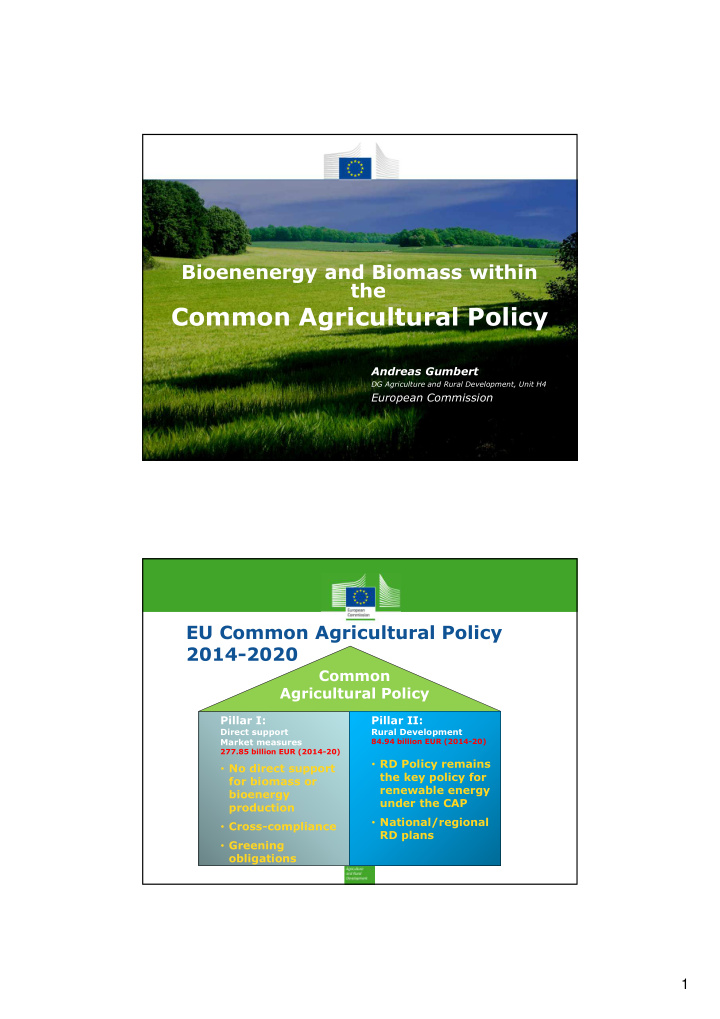



Bioenenergy and Biomass within the Common Agricultural Policy Andreas Gumbert DG Agriculture and Rural Development, Unit H4 European Commission EU Common Agricultural Policy 2014-2020 Common Agricultural Policy Pillar I: Pillar II: Direct support Rural Development Market measures 84.94 billion EUR (2014-20) 277.85 billion EUR (2014-20) • RD Policy remains • No direct support the key policy for for biomass or renewable energy bioenergy under the CAP production • National/regional • Cross-compliance RD plans • Greening obligations 1
CAP 2014-2020 Climate-related measures • New ‘green’ payment in Pillar I • Two environmental priorities for rural development and minimum spending (30%) • Research, innovation and knowledge transfer and an improved Farm Advisory System Rural development Focus areas Cross-cutting priorities objectives Strategic programming (a) innovation, cooperation, and the development of the knowledge base; 1. Knowledge (b) links between agriculture, food production and forestry and research and transfer and innovation; Innovation (c) lifelong learning and vocational training . Innovation , Climate Change and 2. Farm viability, competitiveness, (a) economic performance of all farms and farm restructuring and innovative farm modernisation, notably to increase market participation/orientation and technologies, diversification; sustainable forest (b) facilitating entry of adequately skilled farmers and generational renewal. management Environment 3. Food chain (a) integration of primary producers into the agri-food chain: quality schemes, organisation, incl. adding value, promotion in local markets and short supply circuits, producer processing/marketing, groups/ organisations; animal welfare and (b) farm risk prevention and management. risk management (a) biodiversity, including in Natura 2000 areas, areas facing natural or other 4. Restoring, specific constraints and high nature value farming, and the state of European preserving and landscapes; enhancing (b) water management, including fertiliser and pesticide management; ecosystems (c) prevention of soil erosion and soil management. 30% (a) efficiency in water use 5. Resource efficiency minimal (b) efficiency in energy use and shift towards a spending (c) renewable sources of energy, by products, wastes and non-food raw low carbon and material for the bio-economy climate resilient (d) reduction of greenhouse gas and ammonia emissions economy (e) carbon conservation and sequestration 6. Social inclusion, (a) diversification, creation and development of small enterprises and job poverty reduction creation and economic 4 (b) local development in rural areas development (c) information and communication technologies (ICT) in rural areas in rural areas 2
What type of support is possible under Rural Development? Investments in agricultural holdings General State Aid rules apply for marketing of RE ouside the farm • Examples: • Agricultural holdings : Production of bio-energy for on-farm use • Processing/marketing/development : Processing of agricultural biomass for RE (by actors other than agricultural holdings) • Infrastructure : Installations/infrastructure for distribution of RE using biomass and other RE sources (solar, wind, geothermal) • Conditions ( Commission Delegated Regulation (EU) No 639/2014 ): • Maximum proportions of cereals and other starch rich crops, sugars and oil crops used for bioenergy production, including biofuels • Minimum utilization of heat in installations for electricity production from biomass (level to be determined by the MS) • Minimum energy efficiency standards for investments into energy infrastructure • Sustainability criteria , including Article 17(2) to (6) of Directive 2009/28/EC 6 3
Farm and business development • Examples: • Business start-up for RE producers and inter-linked activities • Creation & development of non-agricultural activities: RE production • Different RE activities (e.g. biomass, wind, solar, geothermal) • RE production as part of non-agricultural diversification activities, if the production exceeds the annual energy consumption on the holding 7 Basic services and village renewal in rural areas • Examples: • Distribution networks for heat/electric power/gas from biomass or other renewable sources • Facilities to produce and use RE in rural municipalities (e.g. district heating networks to use process heat of bio-energy plants) • Support of RE infrastructure possible without any size limitation (i.e. large- scale projects are covered) 8 4
Co-operation and Setting up of producer groups and organisations • Examples cooperation: • Pilot and demonstration projects for RE • Development of new products, practices, processes and technologies for RE • Horizontal and vertical co-operation among supply chain actors in the sustainable provision of biomass for use in food and energy production and industrial processes. • Examples producer groups: • Jointly placing on the market of biomass; joint supply to bulk buyers Conclusions • Bioenergy important for EU renewable energy objectives • EU RE policy main driver • CAP provides important support options under Rural Development Policy • Assessment of RDPs ongoing 5
Thank you 6
Recommend
More recommend